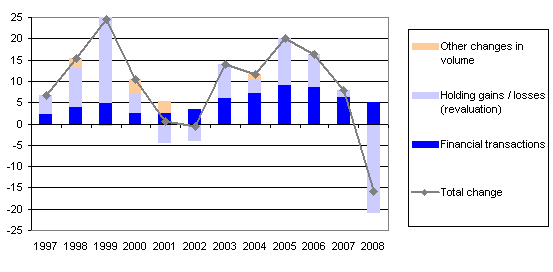Published: 9 July 2009
Households' financial assets decreased strongly in 2008
Holding losses resulting from decreases in the value of security prices pushed the value of households' financial assets to a steep decline in 2008. The value of households' financial assets fell by a total of EUR 16 billion. At the same time the flow from mutual fund shares to deposits which began in 2007 gained strength. The financial position of general government also weakened significantly last year.
In 2008 households' financial assets were influenced by holding losses amounting to a total of EUR 21 billion. Direct investments in shares caused close on EUR 13 billion and mutual fund investments nearly EUR 5 billion of losses. Unit-linked life insurance and pension insurance claims also caused losses amounting to nearly EUR 4 billion. Furthermore, households' financial position weakened indirectly as a result of a decrease in employment pension schemes' reserve assets. However, households acquired a net of EUR 5 billion more financial assets, which is only slightly less than in the year before.
Change in financial assets of households 1997-2008, EUR billion

As exceptional insecurity prevailed in stock and other securities markets, the focus of households' financial assets moved increasingly strongly from securities to deposits. Households moved nearly EUR 8 billion to deposits and at the same time withdrew a good EUR 4 billion from mutual funds. Households' interest in domestic quoted shares revived after a long interval and quoted share purchases amounted to EUR 1.5 billion in net terms.
All in all households' financial assets amounted to EUR 187 billion at the end of 2008. Of this amount EUR 70 billion were deposits, EUR 15 billion quoted shares, EUR 41 billion unquoted equity, EUR 33 billion life and pension insurance savings and EUR 9 billion mutual fund shares. The value of other financial assets was EUR 19 billion.
Households' financial position remained in deficit in 2008. Even though the annual growth in debts slowed down from the year before, indebtedness, i.e. proportion of loans relative to disposable income, rose to 104 per cent. Households' net financial assets, i.e. difference between financial assets and liabilities, shrunk by nearly one-fourth from that in 2007. At the end of 2008 they stood at good EUR 83 billion.
Government sector financial position weakened
Examined through revenue and expenditure, the Finnish general government still showed a strong surplus in 2008. In terms of the sustainability of the public economy, a more important indicator, however, is its financial position. The financial position of the public sector showed a significant turn for the worse as the value of general government financial assets fell by EUR 32 billion in the year. Employment pension schemes' assets consolidated for future pension payments faced EUR 23 billion of holding losses in 2008. The decrease of central government share holdings by EUR 14 billion turned central government net financial assets slightly negative. General government debt increased slightly in 2008.
The focus of employment pension schemes' investments moved in 2008 from shares and mutual fund shares to loans and debt securities. Employment pension schemes lent EUR 3.5 billion to non-financial corporations and added good EUR 3 billion to their debt security investments. Unlike in a few previous years, the focus of investment was now in Finland.
Non-financial corporations' loans increased strongly
The indebtedness of non-financial corporations accelerated in 2008. Acquiring new financing was done nearly entirely by raising new loans, as the market for bonds and commercial paper dried up. The majority of the EUR 31 billion increase in the loan stock came from loans to other non-financial corporations, but credit institutions and employment pension schemes also provided ample loans to non-financial corporations. In short-term financing credits from banks replaced financing with commercial papers. All in all, non-financial corporations increased their short-term bank loans by good EUR 6 billion.
Investments in foreign shares dried up
Finnish investors, especially employment pension schemes, investment funds and households reclaimed their money from foreign shares and mutual funds to the value of EUR 4 billion, whereas in the year before as much as EUR 10 billion of money had been invested in them. However, non-financial corporations continued their direct investments in foreign shares, spending EUR 11 billion on them.
Foreign investors also cut back strongly their holdings of Finnish quoted shares. In all Finnish quoted shares were sold back to domestic investors at a net value of EUR 5 billion. The fall in market quotations to less than one-half from the year before caused the value of foreign share holdings to plummet to EUR 64 billion at the end of the year. The proportion of foreign ownership of the value of Finnish quoted shares also decreased to 59 per cent.
Published contents to be revised
Revised data for 2008 will be published in January 2010. At that time the published contents will be extended significantly to cover i.a. the counterpart sector data of financial assets and liabilities. Historical time series of financial balance sheets for years 1970-1994 will also be published. The paper publication on financial accounts will be discontinued.
Source: Financial Accounts. Statistics Finland
Inquiries: Mr Matti Okko +358 9 1734 3341, Ms Marjatta Roponen +358 9 1734 3323, rahoitus.tilinpito@stat.fi
Director in charge: Mr Ari Tyrkkö
Financial accounts describe the financial assets and liabilities of the sectors of national economy and the financial transactions and other flows that influence their amounts. Financial accounts are compiled in accordance with the European System of Accounts (ESA 1995) in all EU member states.
- Tables
-
Tables in databases
Pick the data you need into tables, view the data as graphs, or download the data for your use.
Appendix tables
- rtp_2008_2009-07-09_tau_001_en.xls (Excel) (9.7.2009)
- Figures
Last updated 9.7.2009
Official Statistics of Finland (OSF):
Financial accounts [e-publication].
ISSN=1458-8145. 2008. Helsinki: Statistics Finland [referred: 10.12.2025].
Access method: http://stat.fi/til/rtp/2008/rtp_2008_2009-07-09_tie_001_en.html

